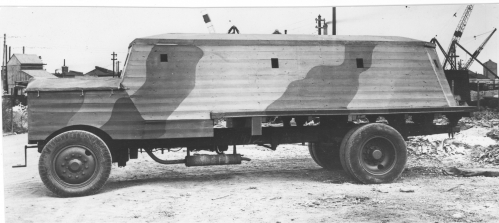| The Bison was designed in 1940, manufactured by Concrete Limited based on the existing 4 x 2 drive commercial truck and was in use from 1940 to 1942. |
|
|
|

HM Goverment, Public domain, via Wikimedia Commons
|
|
| | Specifications | | Operational Date(s) | 1940 - 1942 | | Quantity Produced | 150 | | Weight | unknown | | Crew | 8 | | M.G's small | 1 | | M.G's large(>10mm) | n/a | | Length | 6.20 mtr | | Width | 2.80 mtr | | Height | 3.00 mtr | | Engine Details/Performance | | Max Road Speed | 15 mph | | Max Cross Country Speed | 3 mph | | Range Road | 100 miles | | Range Cross Country | 20 miles | | Fuel Type | Petrol | | Fuel Capacity | unknown | | Horse Power | 75 hp | | Power/Weight | unknown | | | General Information | The Bison was designed in 1940, manufactured by Concrete Limited based on the existing 4 x 2 drive commercial truck and was in use from 1940 to 1942.
The vehicle was powered by Bedford '3.5 L' petrol powerplant producing 75 HP which could drive the vehicle on roads at up to 15 mph with a range of about 100 miles before refuelling. Its cross country performance was poor providing a max speed of about 3 mph and a range of about 20 miles.
It was armed with 1 light machine gun , a Bren Gun. This was a standard heavy british truck with a thick reinforced concrete structure built on top, various designs and truck bases were used so there were very few standard designs.
It was used as a mobile pill box for infantry to be protected from small arms fire, and was mostly used to defend airfields or by the home guard.
The walls were about 6 inches(152mm) thick and made from High Alumina Concrete that made them impervious to small arms fire and armour piercing bullets. | |
Armour Details
(Concrete 1mm equivalent to 0.1200mm RHA) |
|---|
| | Turret | | Front | n/a | | Side | n/a | | Rear | n/a | | Top | n/a |
| | Superstructure | | Front | | 18mm | @ | 0° | (18mm) | | Side | | 18mm | @ | 15° | (19mm) | | Rear | | 18mm | @ | 15° | (19mm) | | Top | | 18mm | @ | 90° | (18mm) |
|
| Hull | | Front | | 18mm | @ | 0° | (18mm) | | Side | | 18mm | @ | 15° | (19mm) | | Rear | | 18mm | @ | 15° | (19mm) | | Top | | 18mm | @ | 90° | (18mm) |
| | Armour (x)mm @ (y)° (Effective mm @ 0°) | | Effective Armour - Maximum 19 mm - Minimum 18 mm |
| |
| Weapon Details |
|---|
|
Bren Gun
(Machine Gun) |
 |
|
| | History | |
|---|
| | The Bren gun was licenced from the Czechoslovak ZB vz.27 light machine gun which was designed and manufactured in Brno from 1935.
It fired the standard British .303 rifle round. |
| | Manufactured | 1930 - 2004 |
|---|
| | Calibre | 7.70mm |
|---|
| | Length | L/82 |
|---|
| | Rate of Fire | 500 rpm |
|---|
| | Number of Rounds | 200
|
|---|
| |
| Ammunition Details |
|---|
| Name/Id |
Calibre Weight MVelocity |
Explosive Content |
|
Standard british .303 round - HPBT
(BALL Standard Small Arms)
|
7.70mm 0.01Kg 761M/Sec | |
| Range(Mtr) | 100 | 200 | 400 | 800 | 1200 | 1600 | 2000 | 2400 |
|---|
| Flight Time(Secs) |
0.17 |
|
|
|
|
|
|
|
|---|
| Penetration(mm@30°) |
1 |
|
|
|
|
|
|
|
|---|
| Penetration(mm@0°) |
2 |
|
|
|
|
|
|
|
|---|
| Hit Probability(%) |
98 |
|
|
|
|
|
|
|
|---|
|
Standard british .303 round
(BALL Standard Small Arms)
|
7.70mm 0.017Kg 783M/Sec | |
| Range(Mtr) | 100 | 200 | 400 | 800 | 1200 | 1600 | 2000 | 2400 |
|---|
| Flight Time(Secs) |
0.15 |
|
|
|
|
|
|
|
|---|
| Penetration(mm@30°) |
4 |
|
|
|
|
|
|
|
|---|
| Penetration(mm@0°) |
5 |
|
|
|
|
|
|
|
|---|
| Hit Probability(%) |
98 |
|
|
|
|
|
|
|
|---|
|
|
|
Hit probability is based on a static 2 x 2.4 metre panel at 0 degrees(vertical) at the range specified.
The data that has been used to create these records has come from Wikipedia, The Lone Sentry, The Bundes Archive
and numerous books and websites that have provided the detailed information that has not been available anywhere else. The
information we use to calculate the penetration tables, flight times and the hit probability comes from the Gun Calibre,
the Shell Mass(Kg) and the muzzle velocity, plus range reductions to allow for gravity and wind resistance. This calculation
originally came from a pre-war Krupp calculation which has been modified, and seems to fit the actual test results.
 
© WWIITanks 1980-2024
If you have any information, or comments on our site,
please E-Mail Simon at
wwiitanks@villagenet.co.uk
Page Last Updated: 2023-01-12 14:47:28
|
|


